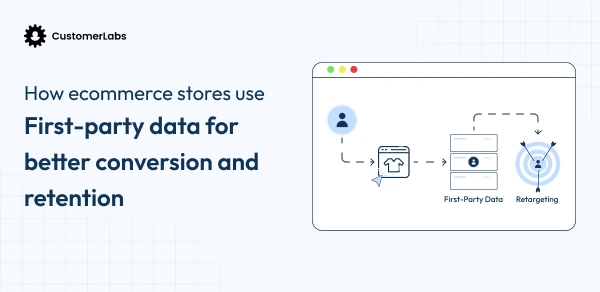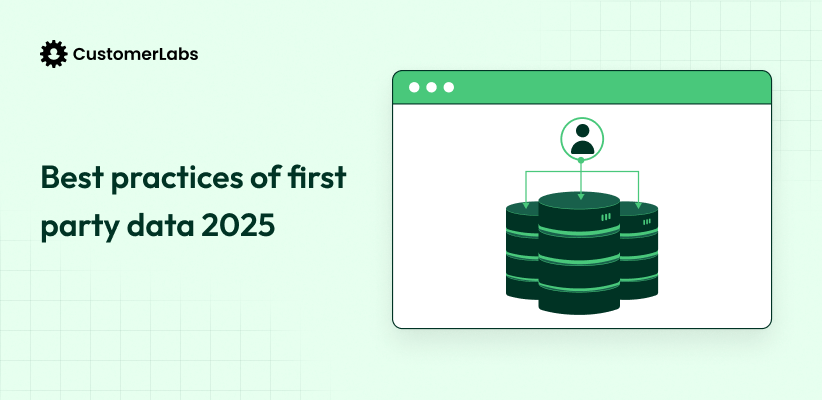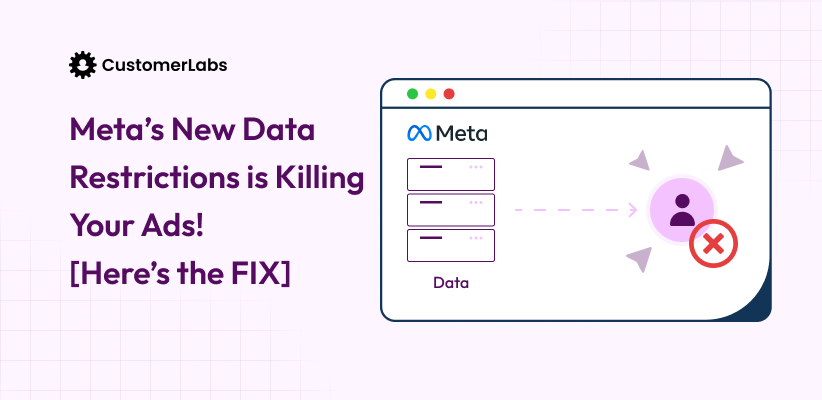Did you know? A 30% RTO rate can wipe out up to 40–50% of your actual ROAS. Return-to-Origin can really be a silent killer for your ecommerce brands. Imagine you are investing in ads happily as you see them bring in good conversion, but when you sit down to calculate your revenue, you see the opposite. Something does not equate.
That can be because of the RTO. You kept calculating the conversion that you are getting from the ads but did not focus on the returning orders. This means that every user that returned the orders is a wasted ad spend. And this is the major problem faced by many D2C brands on Shopify.
How to fix this RTO hole?—With first-party data. If you are curious to know how, read the entire blog and gain actionable 1PD strategies to reduce RTO using their own customer data.
Let’s start with the fundamentals.
P.S. if you are a B2B brand, learn on these B2B first-party data strategies
What is RTO and Why It Happens?
RTO, aka Return to Origin, is nothing but the products that are returned to the brands by the users for varied reasons. This happens only for COD orders, and countries like India are predominantly filled with COD orders when compared to other countries.
What are the common reasons for RTO?
The general common reasons could possibly be
- False purchases by users without the intent of purchasing
- Mismatching shipping details or delivery failures
- Customers refusing COD orders in the last minute
- Users being unavailable during the time of delivery
Most of these are predictable with behavioral signals—the kind that first-party data can capture.
You can read on what Meta says about first-party data
High RTO has a cascading impact on three critical performance levers: your ad campaigns, ROAS, and overall ROI.

Impact of RTO on ROAS and ROI
Let’s say you’re spending $10,000/month on Meta ads, driving 1,000 purchases with an average order value (AOV) of $120.
Gross Revenue (Before RTO): $120,000
Initial ROAS: $120K / $10K = 12
But then, 30% of those orders (300 orders) end up being returned to origin due to failed deliveries or refusal. Now.
Net Revenue (After RTO): $84,000
Actual ROAS: $84K / $10K = 8.4
And that’s not even the full picture.
Here’s what else you’re losing:
Increases CAC (Customer Acquisition Cost)
You are paying heavy dollars to bring in the customers to make the purchases. But when the orders get returned, the dollars that you spent on acquiring these customers bring 0 revenue.
From the above scenario,
You spend $10,000 on Meta ads.
That drives 1,000 purchases.
Your blended CAC looks great: $10 per customer.
But now, say 300 of those orders are RTOs.
Those 300 customers never paid you a dollar.
Now, you’re left with 700 actual customers, but the full $10K was spent acquiring all 1,000.
Your true CAC = $10,000 / 700 = $14.29 per real customer.
So if you are optimizing ads based on $10 CAC, your entire ROAS projection is flawed, Lifetime value models (LTV:CAC ratios) become unreliable, and Profit margins look great in your dashboards—but not in your bank account
Even worse? Most teams don’t account for RTO-adjusted CAC until the monthly reconciliation phase. By that time, you’ve already scaled a broken campaign.

Distorts attribution and Algorithm learning
The ad platform’s algorithm runs on signals. The more accurate signals that you feed them, the more accurate the conversion rate. RTO creates an illusion for the ad platform and misleads them, compromising the conversion. Here’s how:
Most brands fire the “Purchase” event immediately after checkout—not after successful delivery or confirmation. So even when an order is returned, the pixel has only collected the data that says the customer converted.
The ad platforms understand that as successful conversion occurred, they should capture more users like these moving forward and ad optimization happens on the false data. Why this happens is because the ad platforms know only the first half of the story.
Not just that, it also affects the lookalike and retargeting campaigns. How? Lookalike audiences are built based on your custom audiences or seed audience. When the seed audience is filled with high RTO users, 1% or 5% of the lookalike audience might contain users who never paid or never received. You’re spending more, reaching the wrong people, and unknowingly training Meta to repeat the mistake.
In short, you are telling your ad platform:
“Good job, these people are successful purchases!”
When really, they just cost you money, and didn’t bring in revenue
Hurts profit margins due to reverse logistics
Generally the metrics that you keep track of to determine the performances are CAC, ROAS, and AOV religiously. But one thing they miss out on tracking is the Reverse Logistics.
When a product is returned, it is not just a lost sale, but it brings along add-on operational costs. Here’s how:
You would have already paid for the delivery, which would probably be around $5 to $12., if the order gets returned, you would again pay a delivery fee. That’s double the logistics cost for zero revenue.
Plus, to make the product resell-ready, you need manual labor to check for missing tags, wear and tear; there you go, additional labor charges. In these cases, your COGS (Cost of Goods Sold) becomes a total loss, plus you still eat the logistics cost.
If you think the list is done, no, you are wrong. To every RTO order, there is always a trigger to the customer service, inquiring about the order. And this impacts with more support tickets, customer dissatisfaction (even when they’re at fault) and more. And if you offer free returns or free redelivery (a common expectation in the U.S.), your profit margin tanks even further.
Now imagine this happening at 30% scale. That’s why reducing RTO isn’t a nice-to-have—it’s a must for improving true ROAS and scaling profitably.
If your campaigns goal is increase conversion and customer retention with first-party data. Read more

Let’s now understand how to address this major issue by taking a first-party data approach.
Role of First-Party Data in Reducing RTO
By now, you would probably know that ad campaigns are more than clicks. And High RTO equals to Lower POAS.
It is important to rethink that it is essential to train the ad algorithm with the right data for camapign optimization. With first-party data, you can strategically think and move your campaigns with real positives and shut the loophole—RTO.
Read on the importance of first-party data
What role does 1PD play in reducing RTO
- Clean Up Your Audience Targeting
With the user’s delivery and purchase confirmation data, aka, first-party data, you can identify users who have a history of RTOs, cancellations, or unconfirmed COD orders. Segment these users and tag them with names such as rto_flagged or high_risk_rto.
When you set up targeting campaign for high discounts, you can use this user data and add them to the exclusion list. This way, first-party data can reduce the RTO from happening and send in the right signals to ad platforms before targeting.
- Set Smarter Rules for COD Campaigns
Segment the first-party data of the users based on the track record of successful COD delivery. And first-party data can also be used to block COD orders for new users from high-RTO zip codes, users who didn’t respond to order confirmation emails/texts and users with previous failed delivery attempts.
By using first-party data, you are not entirely blocking COD orders; rather, you strategically analyze the data and control the risk of RTO.
Also read on how ecommerce stores can use first-party data for Facebook retargeting and Google retargeting
Up next, let’s break down some real 1PD strategies that can help you address high RTO in the 1PD style.
1PD Strategies to Reduce RTO
Introduce Partial COD
Instead of blocking the entire COD, you can set up partial COD and ask for a small token amount upfront. This partial commitment acts as a filter—only high-intent users proceed.
For instance, a Shopify-based D2C with the problem of high RTOs can test a $3 upfront charge for COD orders, with messaging like “Pay $3 now to confirm your order and the rest on delivery. You’ll also get a $5 discount on your next order.”
Analyze business intelligence data from Shiprocket along with the first-party user behavioral data of purchases and trends like order value, product category, and low-intent customers. And implement this partial COD strategy, which will drop the RTO rates and increase prepaid adoption.
Exclude high-risks users using risks flags
One-click checkout sites like Shiprocket share high-risk flags for orders based on multiple failed deliveries in the past, abandoned COD checkouts, high return rates and many more.
You can identify high-risk users with high RTO probability and then exclude them from high-budget campaigns or push them to partial COD options. You can go further and create negative audiences in Meta ads. This way you can reduce the high RTO and be on the safer side to increase conversions.
Run Prepaid-Only Campaigns for Risky Zones
Try to segment first-party user data based on ZIP code-level delivery performance. Identify regions with high RTOs and run prepaid-only ad campaigns with prepaid incentives such as free shipping.
For instance, you can do geo-targeted personalization and run ad campaigns, which have the probability of reducing RTOs. Additionally, it also prevents operational losses and increases the shift to prepaid orders in low-trust regions.
Segment Audiences Based on Payment Mode Behavior
Segment the first-party data based on payment mode, such as COD or prepaid orders. And set up campaigns with targeted messaging for better conversion.
For the prepaid orders segment, you can push incentives like free shipping and personalized discounts since they are low-risk RTO buyers. Giving incentives for every purchase, would make these users feel valued and want to make repeated purchases with your shopify store or brand? You can also increase the overall LTV of the users by running upsell or cross-sell campaigns and improve customer retention
And for the COD segment, as mentioned earlier, you can try applying the partial COD strategy. This way you are not losing or neglecting any users but targeting strategically purely based on the user behavioral data.
Enrich Ad platforms with Delivery Status Data
Majority of the time, you send in the purchase event data to feed the ad platforms. Purchase events, when sent to ad platforms along with the RTO purchase, can confuse the ad algorithms and the conversion rate takes a dip for further campaigns due to misleading signals to the ad campaigns.
To send the right signals to ad platforms, you can send in the conversion data post successful delivery of all the COD orders back to the ad platforms. This way, it helps the ad algorithm learn and understand the behavioral traits of the real conversions instead of relying on false positives. Additionally, you can also send in the purchase event data after removing the RTOs to ad platforms before setting up campaigns for targeting, retargeting or creating lookalike audiences. This can be extremely beneficial, as it sends off the right signals to ad platforms, it thereby makes the conversion effective.
Personalize Post-Purchase Journeys
First-party data can help you set up automated triggers with messaging by collecting the post-checkout first-party data of the users. You can integrate the WhatsApp API into your Shopify store using 1PD Ops to send reminders to the users about the delivery, order confirmation and non-delivery follow-ups. In this way, first-party data increases the successful delivery rate and reduces forgotten or accidental RTOs.
These are some exclusive 1PD strategies that you can use to reduce the RTO orders and also efficiently train the ad algorithms with proper data signals to drive conversions.
Conclusion
As a performance marketer, you are not responsible for the clicks but the revenue the campaigns yield. Ignoring RTO is like pouring the ad budget into a leaky bucket. If 30% of those conversions are returning to origin, your ROAS is artificially inflated, your ad algorithms is being trained on low-quality events, and your campaigns are bleeding efficiency. That’s why Return to Origin (RTO) isn’t just a logistics metric, but a growth blocker for your ad campaigns. By activating your first-party data, you move from reaction to prevention—targeting the right users, filtering out bad leads, and guiding actual customers all the way to delivery. All these strategies can contribute in increasing ROAS for your ecommerce store using first-party data.
Start optimizing for delivered conversions, not abandoned ones. Let’s help you integrate your first-party data stack and reduce RTO—without touching your ad budget.
Book a strategy call now and let’s turn your returns into retained revenue.







